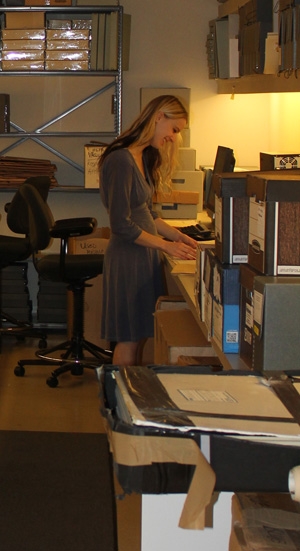By Molly Marcusse, Archives Assistant

My name is Molly Marcusse and I work as the archival assistant in the Niels Bohr Library and Archives (NBL&A). I have been in this position for about a year and a half and I really enjoy the work that I do here. I graduated with my Master of Library Science from University of Maryland with a concentration in archives and records management in December 2013. As the archival assistant, I am here to support the work of the full-time archivists and librarians in a variety of ways. This position also gives me the opportunity to gain hands-on experience in conjunction with the theories that I have learned in my classes. My main projects at the NBL&A have been to process archival collections and digitize the minutes of AIP Governing Board and Executive Committee meetings.
Digitizing the minutes involves using Optical Character Recognition (or OCR) on PDFs of the minutes. I then use Adobe Dreamweaver to do the HTML and javascript coding before the minutes are published to the Library’s website. The Governing Board minutes are available through the end of 1988 and the Executive Committee minutes are updated as they are completed, with the goal of making all minutes through the end of 1988 available online.
Processing archival collections prepares them for use by researchers. This involves re-housing the records to acid-free folders and boxes to prevent deterioration of the paper. Ideally when collections arrive at the NBL&A they will be in folders with titles. When this happens, I use the original folder titles; when this is not the case, I have to create a folder title which concisely and accurately describes the records in the folder. Quality folder titles help researchers decide if a folder contains relevant records without having to spend time actually looking at the records. I also remove any staples or paper clips that are damaging the paper and photocopy paper which is already decaying. (Early fax paper is the worst!) Processing also involves writing a finding aid which describes the collection, who created the records, how the records are organized, and contains a folder title list. Many of our finding aids are available online. This allows researchers to assess a collection’s usefulness before they ever step foot in the NBL&A.
Working at the NBL&A has given me the opportunity to learn from our historical materials. For example, one of the archival collections I processed was primarily records about quantum physics, an area that I never thought I would find interesting. By working directly with the records I was able to gain a new appreciation and understanding of concepts like Schrödinger's cat and Young’s interference experiment. As a member of the Library staff, the best part about getting to learn while at work is sharing my excitement about the history of physics with others.
